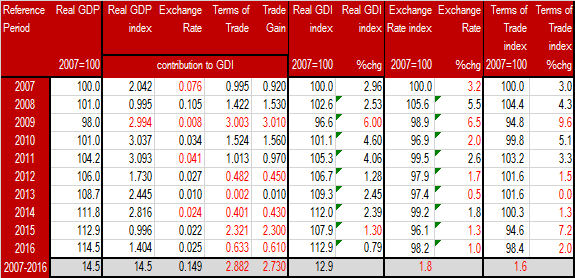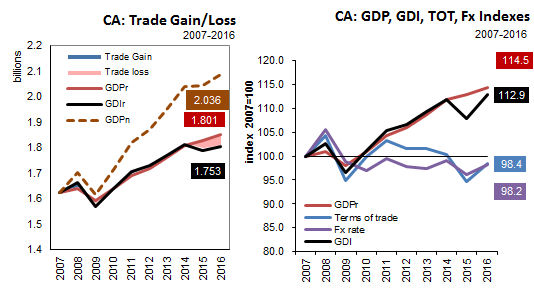The Economics and Statistics Division maintains archives of previous publications for accountability purposes, but makes no updates to keep these documents current with the latest data revisions from Statistics Canada. As a result, information in older documents may not be accurate. Please exercise caution when referring to older documents. For the latest information and historical data, please contact the individual listed to the right.
<--- Return to Archive
For additional information relating to this article, please contact:
April 25, 2018CANADA INTERNATIONAL TRADE PERFORMANCE 2016: PURCHASING POWER CANADA PURCHASING POWER

When computing the contribution to growth of rGDI, the contribution of growth in rGDP is taken at full value, while the contribution of terms of trade and the contribution of the real exchange rate is dependant (weighted) on the relative size of the export and import market, and price changes in these markets.
Over the period 2007 to 2016, Canada’s rGDP increased 14.5 points. Canada’s terms of trade index declined 1.6 points but its contribution to growth in rGDI was -2.882 points.
The real exchange rate index decreased 1.8% over the period, but its contribution to growth in rGDI was only a positive 0.149%.
Together the contribution of the real exchange rate growth (+0.149 points), less the declining contribution of the terms of trade (-2.882 points) yields a net negative growth in the “trade gain” of -2.730 points. The “trade gain” decline, combined with the increase of 14.5% in rGDP, results in a positive growth rate of 12.9% in the rGDI index over the 2007-2016 period to 112.9.
As the growth rate in rGDI (12.9%) is less than the growth rate in rGDP (14.5%), then Canada’s purchasing power has declined 1.6 points over the period. (114.5 – 112.9 = 1.6).
In Canada 2016, the purchasing power index (rGDI) increased by 0.79% from 2015 to 112.9 (2007=100). Real gross domestic product’s contribution increased rGDI growth by 1.404 points, the “trading gain” contribution and the real exchange rate contribution increased rGDI growth by 0.025 percentage points, and terms of trade contribution decreased rGDI growth by 0.633 percentage points. (1.404 + 0.025 – 0.633 = +0.79).

Computed from CANSIM Tables 384-0038.
<--- Return to Archive